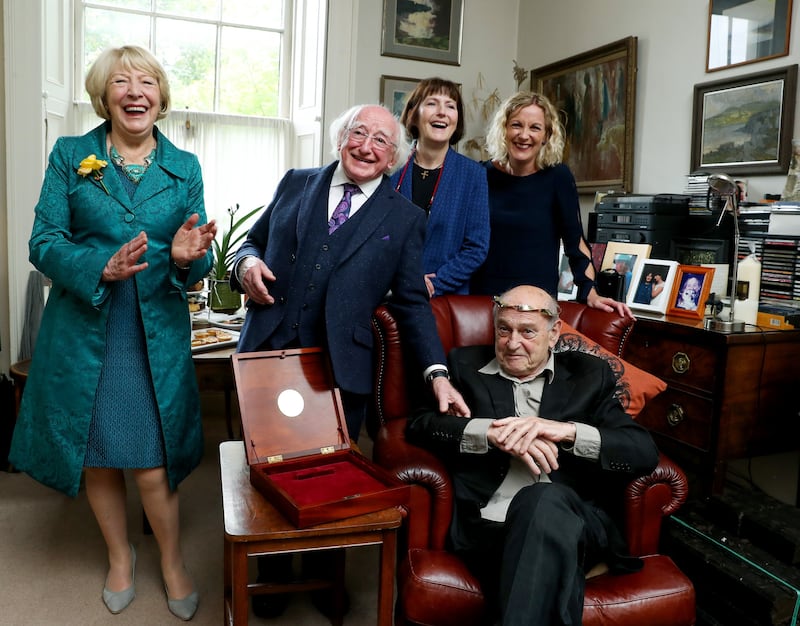If Tom Murphy were a different kind of writer his work over almost 60 years would fall into two distinct categories. One would be a fierce, unflinching social realism, an inner history of Irish life and, especially, of the displacements of emigration and return. It would run from his first one-act play, On the Outside, through A Whistle in the Dark and Conversations on a Homecoming to The Wake and The House. The other would be the work of a vividly imaginative fabulist, the spinner of extraordinary theatrical myths, from The Morning After Optimism to The Sanctuary Lamp, The Gigli Concert and Bailegangaire. And in either one of these categories we would find a body of work that could stand with the best plays in the English language over this long period.
But Murphy is not in fact that kind of writer. There are certainly these two strains in his work: the harsh, even brutal realism and the exuberantly daring mythmaking. What makes him so remarkable, though, is the way they are interwoven. Murphy’s kitchen sink overflows with the heavy water of fantastic yearnings. His myths, on the other hand, have their feet firmly planted in the foul rag-and-bone shop of mundane and sordid reality. He is a social surrealist. He creates plays of violent beauty and of soaring brutality. His people, like all of us, are at once apes and angels. And this is what makes him great.
Murphy's is an astounding body of work: its range, ambition, originality and bravery are utterly remarkable
With his recent elevation to the highest civic honour, that of Saoi of Aosdána, and with Thursday evening's celebration of his life and work at Trinity College Dublin it may be that Murphy is edging dangerously close to his apotheosis. But his is an astounding body of work: its range, ambition, originality and bravery are utterly remarkable. Ireland tends to exaggerate native achievements, but Murphy's reputation has never entirely matched his. It is hard to think of more than half a dozen of his contemporaries in the English-speaking theatre who have created so much work of such high voltage. His plays are a powerhouse of ideas and emotions that will surely go on generating electric performances for many decades to come. It is striking, for example, how powerful an influence he is on the English playwright of the moment, Jez Butterworth.
The great artists are the paradoxical ones who seem defiantly individual yet deeply immersed in a tradition, who are both revolutionaries and conservatives. And perhaps a deeper appreciation of Murphy is now emerging because the conservative side is becoming more visible. It has always been easy, and wholly accurate, to see Murphy in the classic stance of the modernist Irish writer, at war with the pieties of religion, family and nationality. There is a rage in his plays against the class-ridden hypocrisies and meanness of the Irish society he grew up in as a child of working-class Tuam: the cruelty of a place that blithely exported its people to the old colonial enemy, the violence of the hatred created by these rejections, the poverty of circumstance and of spirit. There is nothing in contemporary Irish writing, even with all its heretics and apostates, quite so ferociously anti-Catholic as Francisco's blasphemous rant against the church delivered from the pulpit in The Sanctuary Lamp.

But Murphy is not content with a realist assault on religion. His work is also a yearning for transcendence. The burning rage is also a flame held up in the dark, searching for something that might give meaning to suffering. In his later plays he uses his rage as a battering ram to break through to another side of reality, where spiritual yearning, even if it cannot be satisfied, can at least be expressed. And what expression he gives it. Murphy is no raw materialist: his people have souls, and the windows to them are the sounds they make. His imagination is musical. His language is pitched perfectly between the demotic and the operatic, functioning at once as realistic dialogue and as unconscious self-revelation. The plays are vocal scores, in which each voice has its own signature. Even if they are yelping in pain or roaring in anger his characters are unconsciously constructing the unique soundscapes that are their selves.
Murphy creates his own myths, using them in the same way the Greek dramatists used theirs: to create a multilayered reality on stage
And if Murphy is up in arms against the Irish Catholicism of his youth he is also trying to find some kind of psychic equivalent. This is where he is as much a conservative as he is a rebel. His work is in a constant dialogue not just with giants of the modern theatrical tradition like Synge, Chekhov and O'Neill but also with older theatrical myths. The Gigli Concert is a version of Goethe's Faust, The Sanctuary Lamp of The Oresteia. Even the apparent in-your-face contemporary realism of A Whistle in the Dark hides a perfectly constructed Greek tragedy. He creates his own myths, most notably the fatal laughing contest of Bailegangaire and A Thief of a Christmas, but uses them in the same way the Greek dramatists used theirs: to create a multilayered reality on stage, where characters are pulled along by two different logics at the same time.
This is where theatre has always had its most potent life. At its best it’s a form of psychic exposure. It’s a paradox: a space safe enough for us to share with the dangerous wildness of human agony and aspiration. Murphy has occupied it majestically.











